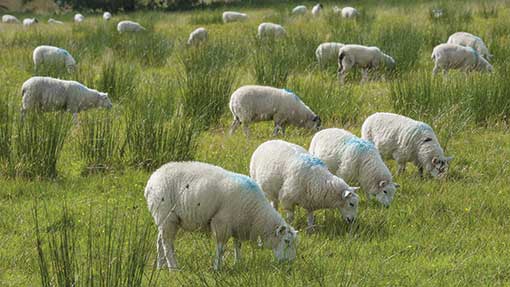Farmers warned to treat blowfly strike early

Sheep farmers may need to treat for blowfly strike earlier than last season because of the recent warm, humid conditions.
Blowfly strike is caused by the infestation of fly maggots that feed directly on the skin of infected animals. In the UK it is estimated that it affects more than 80% of sheep farms.
Cases of blowfly strike have already been reported on two farms in the Midlands and south-east of England. This contrasts with last year, when the cold spring meant blowfly treatment wasn’t required until much later in the summer.
Symptoms
- Foul-smelling lesions with maggots visible
- Matted and discoloured wool
- Agitated behaviour such as gnawing or rubbing of the tail or breech
SRUC vet investigative officer Marion McMillan says a combination of warm and moist weather means blowfly risk could be a lot higher compared with last season.
“This year the temperature is rising and we are still getting enough rainfall for it to be quite humid. High temperatures and humidity provide optimal conditions for maggot development,” explains Mrs McMillan.
See also: Tips for treating cattle and sheep for worms
Fiona Anderson, vet adviser at Novartis Animal Health says flies begin to emerge from overwintered pupae in the soil as temperatures rise above 9C and lay eggs in sheep fleeces, which then hatch into maggots within 10-12 hours.
She says the focus should be on preventing blowfly strike from occurring.
“Prevention is always best in the case of blowfly strike because adult flies can lay so many eggs in the fleece and the strike can establish very quickly.”
Mrs McMillan says choice of chemical will be dictated by meat withdrawal periods and length of protection required.
Pour-ons
Pour-on treatments, which have a shorter meat withdrawal time – as low as seven days – may be preferable for farmers wishing to sell fat lambs relatively quickly.
“Pour-on chemicals dissolve in the wool grease and will be removed when animals are shorn, including crutching to remove dirty wool, so reapplication may be required,” she adds.
Dipping
“Plunge dipping in organophosphate dip can provide protection from blowfly for up to 60 days,” says Mrs McMillan. However, OP dips tend to have longer withdrawal periods and poor dipping practice can lead to a failure to control blowfly strike, she explains.
“Sheep need at least three weeks’ fleece growth for the insecticide to bind.” And she says fleeces must be clean and dry to avoid the dip from becoming contaminated and reducing efficacy.
She says measures can also be taken to prevent the attraction of flies. “Dagging certainly can make a big difference and good parasite control is important, because anything with scours will be at higher risk of flystrike,” she adds.
| Treatment options | ||||
|---|---|---|---|---|
| Active ingredient | Prevention | Cover | Treatment | Withdrawal period |
| Diazinon | Yes | Up to six weeks | Yes | 49-70 days |
| Dicyclanil | Yes | Eight to 16 weeks (depending on product used) | No | 7-40 days |
| Cyromazine | Yes | Eight to 10 weeks | No | 28 days |
| Cypermethrin | Yes | Six to eight weeks | Yes | Eight days |
| Alphacypermethrin | Yes | Up to six weeks | Yes | 49 days |
| Deltamethrin | No | – | Yes | 35 days |
